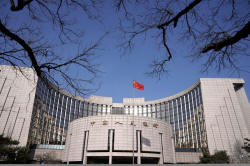|
In
its second-quarter monetary policy implementation report, the
People's Bank of China said it would keep liquidity reasonably
ample and step up support for technology innovation, small firms
and the manufacturing sector.
"The global epidemic is still evolving, the external environment
is becoming more severe and complex, and the domestic economic
recovery is still unstable and uneven," the central bank said.
On the external environment, the PBOC cited a rebound in
COVID-19 cases globally and the risk from expected policy shifts
in developed countries that could affect cross-border capital
flows.
It pledged to "grasp the strength and rhythm of policy"
according to the domestic economic situation and price trend to
maintain the overall stability of the economy.
China is poised to accelerate spending on infrastructure
projects while the central bank supports with modest easing
steps, as risks from the Delta variant and floods threaten to
slow the country's recovery, policy insiders and analysts said.
Effective July 15, the PBOC cut the reserve requirement ratio (RRR)
for banks, releasing around 1 trillion yuan ($6.48 trillion) in
long-term liquidity. Analysts expect another RRR cut this year.
At the end of June, the excess reserve ratio of Chinese
financial institutions was at 1.2%, down 0.4 percentage point
lower from a year earlier, the central bank said.
The weighted average corporate lending rate was at 4.58% in
June, down 0.06 percentage points from a year earlier, it added.
China will promote the healthy development of capital markets
and better protect the interests of investors, the central bank
said.
($1 = 0.1544 Chinese yuan renminbi)
(Reporting by Colin Qian, Judy Hua and Kevin YaoEditing by David
Goodman and Susan Fenton)
[© 2021 Thomson Reuters. All rights
reserved.] Copyright 2021 Reuters. All rights reserved. This material may not be published,
broadcast, rewritten or redistributed.
Thompson Reuters is solely responsible for this content.

|
|





